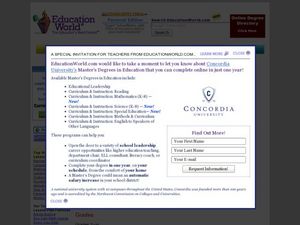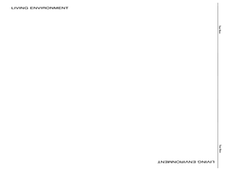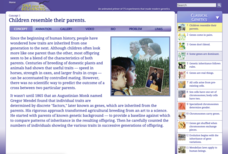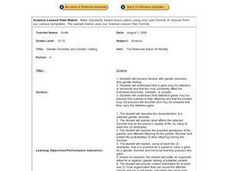Curated OER
Mother and Baby Animals 3
Young learners use a word bank to write the names of mother and baby animals next to their pictures. They complete four easy mazes which connect parents to babies.
Curated OER
Baby Animals Debut at Zoos
Students determine the names of animal babies, then read a news article about zoo's experiencing animal births. In this current events lesson, the teacher introduces the article with vocabulary activities, then students read the news...
Curated OER
Animals and Animal Babies
Students examine how some animal young are similar to the adult. They look at pictures of various animals and their young and identify if they look similar or not similar to the adult animal, and draw a picture of a baby and parent...
Curated OER
Is That Your offspring?
In this animal worksheet, study the names of animal offspring. Students complete 2 word searches finding the offspring vocabulary in one and the parent names in the other.
Curated OER
A Prickle of Hedgehogs
Students, individually or in groups, conduct research to find information needed to complete a worksheet in which they must match an animal name with 1) the name of its offspring (dog-puppy) and 2) its animal group name (geese-gaggle.)
Curated OER
Regents High School Exam: Living Environment 2008
Tne New York Regents High School Examinations are comprehensive and include various styles of questions, includingmultiple choice and the analysis of graphs. This particular version, the 2008 Living Environment exam surveys a variety of...
US National Library of Medicine
Monster Genetics Lab
Harness young scientists' knowledge of genetics with an engaging science activity. Students start by flipping a coin to determine the genotypes and phenotypes of two parent monsters, before using Punnett squares to determine the...
Curated OER
Animal Names
Students match animal pictures with animal words. In this farm animal lesson, students put together the parent and their offspring. Students should have prior knowledge of the basic needs of animals. Students write animal booklets.
Curated OER
Which Baby Animals Looks Unlike Their Parents?
Learners review the steps of the butterfly life cycle to show how the babies are different from the parents. This learning exercise is a graphic organizer with four fill in the blank statements.
Curated OER
Activity: Gummy Bear Genetics
Who's your Daddy ... and Mommy for that matter? Given a first-generation group of gummy bear offspring, young scientists must determine which bears are their parents. An activity worksheet covers the differences in genotypes and...
Cold Spring Harbor Laboratory
Children Resemble Their Parents
Gregor Mendel's work revolutionized agriculture from an art to a science. Explore Mendel's work with an interactive lesson that includes animations, video, and practice problems. The instruction describes the early discoveries that...
Curated OER
Continuing Life
In this reproduction worksheet, students will review the genetic processes in sexual reproduction and asexual reproduction by answering 6 true or false statements. Then students will complete 2 short answer questions about the offspring...
Curated OER
Baby Animals
Students study baby penguins and whales. They name the penguin body parts and examine how penguins hatch from eggs. They name whale body parts and their function. They participate in a whale role play activity.
Curated OER
Help the Mommy Animal Find Her Babies
In this language arts activity, learners learn the names of mother animals and the babies by examining 4 sets of pictures. Using the word bank, students write the names by the pictures of the big and little animals. Then learners trace...
Curated OER
A Look At Penguin Life
Students read a story about Penguin Life and answer vocabulary and comprehension questions about it. In this penguin life lesson plan, students respond to literature by researching penguins and creating a Venn diagram to compare/contrast...
Oklahoma State University
Hairy Heredity
Young scholars learn that heredity comes down to the flip of a coin with this cross-curricular math and science lesson. Using smiley faces as a model, students toss coins to determine which dominant or recessive traits will be passed on...
Curated OER
Genetics Practice 1: Basic Mendelian Genetics
Six genetics problems are to be solved by junior geneticists. Empty Punnett squares are provided for them to plant the parents' alleles and determine the genotype, phenotype, and frequency of offspring. All of the problems involve actual...
Curated OER
Plant Power
Here is an opportunity for your first graders to take a close look at plants: what they need to survive, how they grow, and the names of each plant part. The book, Corduroy's Garden is used to open the lesson. Then, youngsters utilize...
Curated OER
Plants 1: Plant Parents
Students review their prior knowledge on plants. In groups, they compare and contrast the difference between reproducing asexually and sexually. Using the internet, they research how some plants can be forced to produce asexually.
Curated OER
Genetic Disorder and Genetic Testing
Sixth graders explore the characteristics of a selected genetic disorder and research relevant information to justify an argument either for or against genetic testing. Your class can work in groups to gather specific information in...
Curated OER
Family Lesson Plan
Kindergarteners discuss families with this resource. They talk about human families, explaining how they grow and change, and focus on vocabulary words. Then, they talk about animal families, discuss the vocabulary involved, and match...
Curated OER
Genetics with a Smile
In this genetics worksheet, students are given two coins that they mark with a "F" and a "M" to represent parents. They flip the coins to determine the genotype and phenotype of the offspring for twelve traits. They also use the coin to...
Curated OER
Pea Plants Dihybrid Cross
In this dihybrid cross learning exercise, students are given four crosses to complete using punnett squares. They determine the genotypic and phenotypic ratios of the offspring.
Curated OER
More Zork Genetics
In this genetics worksheet, learners complete 3 dihybrid crosses of traits to determine the probability of the genotypes and phenotypes of the offspring of the imaginary species, the Zork.

























